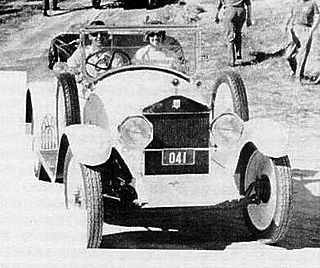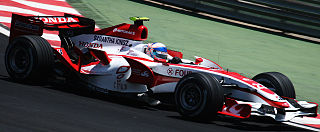Related Research Articles

Automobiles Ettore Bugatti was a French car manufacturer of high-performance automobiles, founded in 1909 in the then-German city of Molsheim, Alsace by the Italian-born industrial designer Ettore Bugatti. The cars were known for their design beauty and for their many race victories. Famous Bugattis include the Type 35 Grand Prix cars, the Type 41 "Royale", the Type 57 "Atlantic" and the Type 55 sports car.

The Hudson Motor Car Company made Hudson and other brand automobiles in Detroit, Michigan, U.S., from 1909 to 1954. In 1954, Hudson merged with Nash-Kelvinator to form American Motors Corporation (AMC). The Hudson name was continued through the 1957 model year, after which it was discontinued.

Zeta is a marque of automobile which was produced in Australia from 1963 to 1965 by South Australian manufacturing company Lightburn & Co.

L'Aster, Aster, Ateliers de Construction Mecanique l'Aster, was a French manufacturer of automobiles and the leading supplier of engines to other manufacturers from the late 1890s until circa 1910/12. Although primarily known as an engine mass manufacturer the company also produced chassis for coach-works and a complete range of components.

The Australian Six was an Australian automobile manufactured from 1919 to 1925. It was a grandiose attempt to compete against imported cars from the United States, and was produced from a mixture of local and imported parts. Vehicles featured a conventional chassis layout and a choice of five bodies, locally made under the motto 'Made in Australia, by Australians, for Australia'. Most models were fitted with Rutenber Straight-6 engines and Grand Lees or Muncie gearboxes; some, however, had imported OHV Ansted engines instead. Before 1919 the factory was at the Sydney Harbour side suburb of Rushcutters Bay, New South Wales, it then moved to Ashfield until 1924. The company was forced to shut down production after some 500 cars were built; this was due mainly to high local construction costs. The final few cars were made by the Harkness and Hillier hire car company in Sydney. Sixteen Australian Sixes survive, one in the Powerhouse Museum automobile collection in Sydney, one in the York Motor Museum, York, Western Australia, this is one of the first six built without a chassis number in the first factory.

Ballot was a French manufacturer, initially of engines, that also made automobiles between 1919 and 1932. Édouard Ballot became well known as a designer of reliable engines. He helped Ettore Bugatti in developing his first engines.
Berliet was a French manufacturer of automobiles, buses, trucks and military vehicles among other vehicles based in Vénissieux, outside of Lyon, France. Founded in 1899, and apart from a five-year period from 1944 to 1949 when it was put into 'administration sequestre' it was in private ownership until 1967 when it then became part of Citroën, and subsequently acquired by Renault in 1974 and merged with Saviem into a new Renault Trucks company in 1978. The Berliet marque was phased out by 1980.

The Terraplane was a car brand and model built by the Hudson Motor Car Company of Detroit, Michigan, between 1932 and 1938. In its maiden year, the car was branded as the Essex-Terraplane; in 1934 the car became simply the Terraplane. They were inexpensive, yet powerful vehicles that were used in both town and country, as both cars and trucks bore the Terraplane name.

Stevens-Duryea was an American manufacturer of automobiles in Chicopee Falls, Massachusetts, between 1901 and 1915 and from 1919 to 1927.

Automotive design is the process of developing the appearance, and to some extent the ergonomics, of motor vehicles, including automobiles, motorcycles, trucks, buses, coaches, and vans.

The Austin 7 is an economy car that was produced from 1923 until 1939 in the United Kingdom by Austin. It was nicknamed the "Baby Austin" and was at that time one of the most popular cars produced for the British market and sold well abroad. Its effect on the British market was similar to that of the Model T Ford in the US, replacing most other British economy cars and cyclecars of the early 1920s. It was also licensed and copied by companies all over the world. The very first BMW car, the BMW Dixi, was a licensed Austin 7. In France they were made and sold as Rosengarts, and in the United States they were built by the American Austin Car Company. In Japan, Nissan also used the 7 design as the basis for their first cars, although not under licence. This eventually led to a 1952 agreement for Nissan to build and sell Austins in Japan under the Austin name.

The Sfakianakis group of companies is a Greek conglomerate with a wide range of activities, employing over 2800 in 6 countries in 2014.

The Volvo ÖV 4 was the first car built by Volvo. The designation ÖV 4 stands for "Öppen Vagn 4 cylindrar" in Swedish, which means Open Carriage, 4 cylinders. The model ÖV 4 was often referred to as "Jakob" but that was just a name for one of the 10 pre-series ÖV 4 that was ready on 25 July, Jakob's name day. All 10 prototypes were assembled in Stockholm at the company AB Galco, Hälsingegatan 41 where Gustav Larson worked at that time. Only one of the 10 pre-series cars manufactured during 1926 was saved for posterity and is housed at the Volvo Museum in Gothenburg, Sweden.

The Coats Steamer was an American steam automobile promotion by George A. Coats. A corporation was formed and perhaps two prototypes were assembled. Five incrementally different designs were described. The first was by a "Norwegian engineer" and used two three-cylinder radial engines on the rear axle, one powering each wheel. The second was by James Yeikichi Sakuyama, for years an engine designer at Indianapolis, with a V-3 engine, gearbox and cast grid steam generator. It was quickly changed to a fire tube steam generator and inline-3 cylinder engine flat in the chassis. The fourth design took that Sakuyama chassis and engine and replaced the steam system in late 1923 with Charles A. French's patent design. The French-Coats was technically the most superior, probably the most likely to have been functional, and the car used in photographs. The fifth design was simply the chassis of Purdue professor Allen C. Staley, shown as a high grade Coats steam car at three shows. The car price remained the same at $1085 throughout the promotion, and dealerships and distributorships were sold to finance the development and sales effort. Eventually Coats obtained the confidence of Y. F. Stewart who had manufacturing facilities. A pickle factory in Bowling Green, Ohio was obtained and a defunct coachbuilder's factory in Columbus, Ohio was purchased. The Cumberland tire company was shown in advertisements as a third factory, as they were to be the tire supplier. All was gone by mid 1924 when the Columbus plant was sold. Coats went on to many enthusiastic promotions including road building equipment in 1924 in New Jersey and inadvertently became one of the creators of the syndicate which quickly became CBS. He stayed in radio promotion in New York City and was buried in the family cemetery in Indiana.

Zimmer was an American automaker, based in Syracuse, New York. The original company was founded in 1978 as Zimmer Motorcars Corporation by Paul Zimmer.

The Super Aguri F1 SA07 was Super Aguri F1's Formula One car for the 2007 Formula One season. It was designed by Peter McCool and was driven by Takuma Sato and Anthony Davidson.
The SA was Toyota's first new passenger car design after World War II. It was the first in a family of vehicles before the introduction of the Crown. A series of light trucks also shared the chassis and major components of these passenger cars.

Meadows Frisky is the name of a series of small British cars manufactured at the factory of Henry Meadows Ltd at Fallings Park in Wolverhampton between 1958 and 1961, during which time, production was under the control of a number of companies.
The Sport was a newspaper published in Adelaide between April 1911 and October 1948, which apart from articles on racing, football, cricket, and boxing, carried items of general interest, satire and political comment.

Duncan & Fraser Limited was a vehicle manufacturing company founded in 1865 in Adelaide, South Australia that built horse-drawn carriages and horse trams, and subsequently bodies for trains, electric trams and motor cars, becoming one of the largest carriage building companies in Australia.
References
- ↑ Manning Index of South Australian History – State Library of SA
- ↑ Biographical details of Clarence Chick, "Designer of the All-British Chic Car", The Register, 14 June 1924, page 8
- ↑ "LOCALLY-DESIGNED CAR". The News (HOME ed.). Adelaide. 23 October 1923. p. 4. Retrieved 27 January 2020– via Trove.
- ↑ "THE CHIC CAR". The Register . Adelaide. 2 April 1924. p. 4. Retrieved 27 January 2020– via Trove.
- ↑ Chick Family